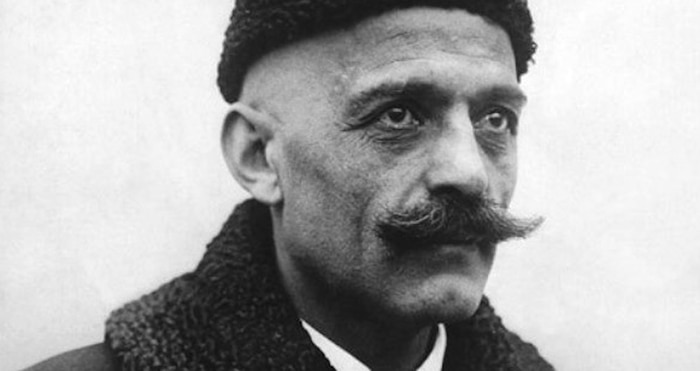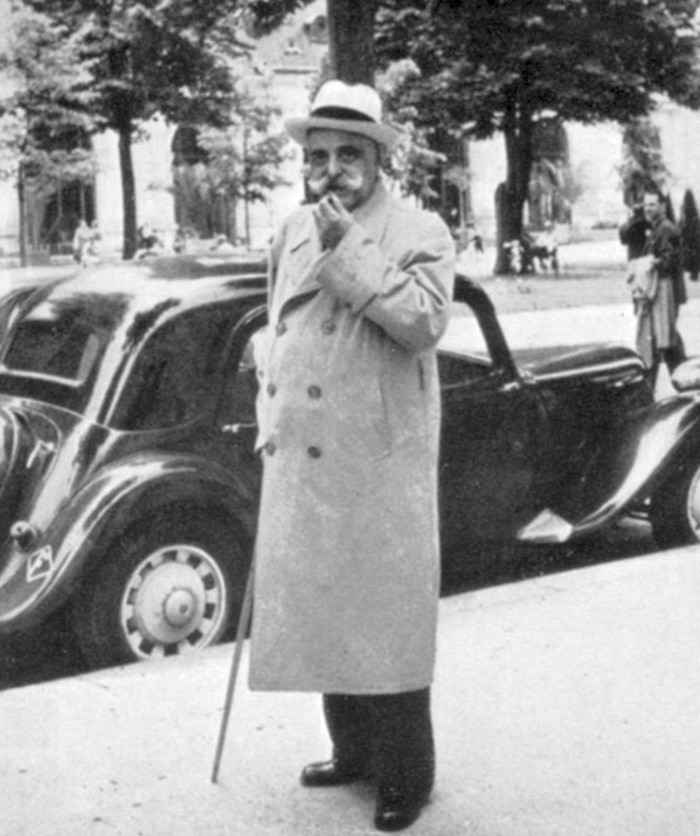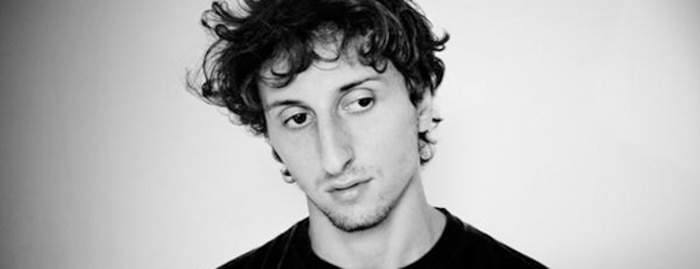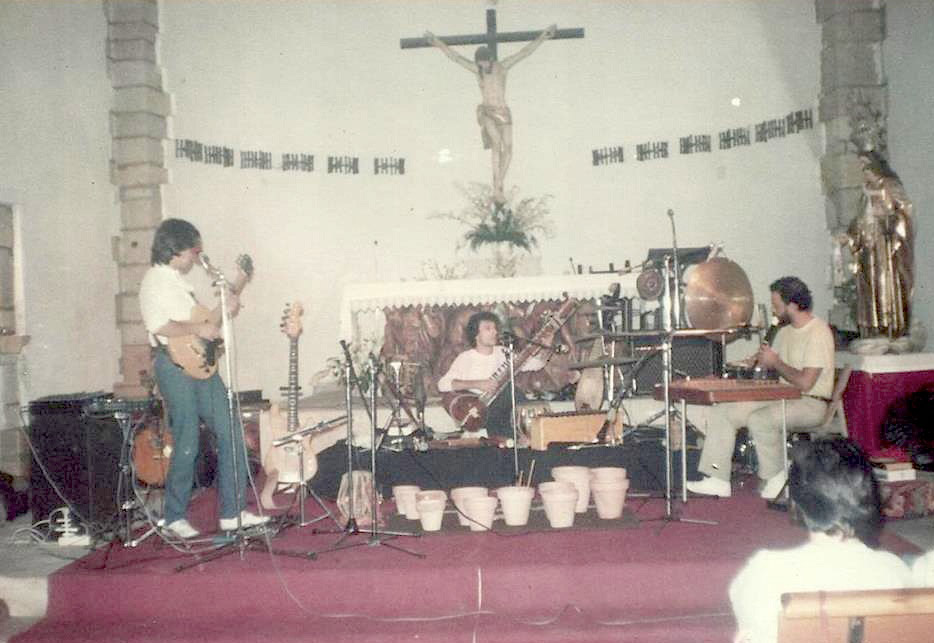Why Are We Sleeping? The Wide Awake World of G.I. Gurdjieff
Mark Pilkington offers a window into the philosophy and music of the “esoteric Christian.”

"Man is immersed in dreams... He lives in sleep… He is a machine. He cannot stop the flow of his thoughts, he cannot control his imagination, his emotions, his attention... He does not see the real world. The real world is hidden from him by the wall of imagination."
Light in the Attic’s epic compilation of New Age music, I Am the Center, opens with “The Struggle of The Magicians,” a powerful yet restrained piano work by the celebrated Ukrainian Russian composer Thomas de Hartmann. Written in the mid ’20s, the piece is a score for an unperformed ballet by De Hartmann’s guru, the enigmatic Armenian mystic George Ivanovich Gurdjieff.
Charismatic, charming and at times powerfully overbearing, Gurdjieff cultivated an aura of wisdom and mystery that fascinated some of the smartest seekers of his day. An international man of mystery, Gurdjieff travelled the world sharing his vision, surrounded by disciples, lovers and benefactors. He was rumoured to be an emissary of the Dali Lama, as well as a spy, and was banned from taking up residence in London as a result. Adding to the cloak of intrigue, he was known to spend money copiously, yet never seemed to run short.
De Hartmann and his wife Olga met Gurdjieff in 1916 and quickly fell under his spell, dedicating the rest of their lives to studying and promoting his teachings, known as The Work. That “The Struggle of The Magicians” should open I Am the Center seems fitting for a man who would exert an unshakable influence on the New Age culture that emerged after his death.

Little is known about Gurdjieff’s early life, and he chose to keep it that way. He was born in Alexandrapol in 1866, the son of a local bard. He’s said to have joined an esoteric order, the Seekers of Truth and – inspired by the mystical writings of Theosophical Society founder Helena Blavatsky – travelled across Asia in search of the Ascended Masters, or Mahatmas, from whom she claimed to channel her wisdom. He wrote an entertaining, heavily mythologised account of these early travels, Meetings with Remarkable Men, which was filmed by Peter Brook, a disciple of The Work, in 1979.
Little is known about Gurdjieff’s early life, and he chose to keep it that way.
In the scene below we see a performance of one of the traditional “Sacred Dances” that Gurdjieff transformed into his own Movements. For Gurdjieff the dances reflected the movements of the solar system, and connect the performers and their audience to the cosmos around them and the spirit within.
"In the strictly defined movements and combinations of the dancers, certain laws are visually reproduced which are intelligible to those who know them. Such dances are called “sacred dances.” In the course of my travels in the East I have many times witnessed such dances being performed during sacred services in various ancient temples."
The Movements are also on display in this video for Italian prog rocker turned pop star Franco Battiato’s 1981 new wave hit, “Centro di gravità permanente.”
Gurdjieff travelled and taught throughout his life, but his writings are considered largely indecipherable, even by his most ardent disciples. Most of what we know about his teachings comes from his star pupil, the Russian philosopher, novelist and mathematician Peter Ouspensky, in particular his books In Search of the Miraculous and The Fourth Way. The link between the two men was so strong that by 1916 Ouspensky claimed to be engaging in telepathic conversations with his master.
Like Blavatsky before him, Gurdjieff fused Western and Eastern, ancient and modern traditions, drawing on Hindu and Buddhist ideas of non-attachment and reincarnation, notions of classical harmony and geometry (as in the complex ninefold symmetry of the Enneagram), self-awareness and self-development.

“All knowledge can be included in the enneagram and with the help of the enneagram it can be interpreted.”
Gurdjieff championed the examined, waking life of self-observation, what he called his “Being Duty,” and his Fourth Way was a synthesis of what he saw as the three well-trodden paths to enlightenment: the way of the Fakir (requiring endurance and pain), the way of the Monk (requiring asceticism and devotion), and the way of the Yogi (requiring dedicated study). Being something of an athlete and bon viveur himself, as well as a scholar, Gurdjieff saw each of these paths alone as lacking — hence his own Way, combining the body, the soul and the emotions.
He was certainly no ascetic, quite the opposite in fact.
There’s an earthiness to Gurdjieff’s teachings that has no doubt contributed to their enduring popularity. He was certainly no ascetic, quite the opposite in fact: he was commendably human, and unashamedly so – he loved to drink, especially Armagnac Brandy, and he enjoyed smoking opium. He was highly charismatic and a notorious womaniser, said to have fathered over 100 children. Here he is on sex:
“Everything that people do is connected with sex: politics, religion, art, the theater, music, is all ‘sex.’ Do you think people go to the theatre or to church to pray or to see some new play? That is only for the sake of appearances. The principal thing, in the theater as well as in church, is that there will be a lot of women or a lot of men. This is the center of gravity of all gatherings...”
Gurdjieff cultivated artists, writers and musicians as friends.
Gurdjieff cultivated artists, writers and musicians as friends, often falling out spectacularly with them (and often over women). Amongst those who spent time with him were AR Orage, editor of the influential English Modernist journal The New Age, Katherine Mansfield, Frank Lloyd Wright (who compared Gurdjieff to Walt Whitman), Algernon Blackwood and René Daumal, whose later works, including Mount Analogue, are saturated with Gurdjieffian ideas.
Thanks largely to the writings and teachings of Ouspensky, De Hartmann and Orage, Gurdjieff’s legend continued to grow after his death in 1949. As the New Age movement blossomed, its ideas began to reflect and chime with his own, and a new generation of followers emerged.
Gurdjieff often expressed his ideas of cosmic interconnectivity through musical analogies, hosting teaching sessions in which he played harmonium while telling stories. Here he describes his ideas about Objective Music:
“Objective music is all based on ‘inner octaves.’ And it can obtain not only definite psychological results but definite physical results. There can be such music as would freeze water. There can be such music as would kill a man instantaneously... Snake charmers’ music in the East is an approach to objective music, of course very primitive. Very often it is simply one note which is long drawn out, rising and falling only very little; but in this single note ‘inner octaves’ are going on all the time and melodies of ‘inner octaves’ which are inaudible to the ears but felt by the emotional center. And the snake hears this music or, more strictly speaking, he feels it, and he obeys it. The same music, only a little more complicated, and men would obey it.”
In Chile, Oscar Ichazo riffed on Gurdjieff’s ideas about the Enneagram, becoming guru to pastoral psych band Blops and theater director and filmmaker Alejandro Jodorowsky, whose Holy Mountain held a warped mirror up to The Work and Daumal’s Mount Analogue.
In the UK, Kate Bush, Sting, Robert Fripp – whose Frippertronic drones were an attempt to find Gurdjieff’s Objective Music – and Julian Cope are amongst those who have expressed a debt to the Fourth Way, while Peter Gabriel borrowed his label and studio name from Gurdjieff’s writings. In the US, jazz pianist Keith Jarrett recorded an album of de Hartmann and Gurdjieff compositions, while the Spanish Basta! label has released a book and four CD set of Gurdjieff’s harmonium sessions.
Six decades after his death, Gurdjieff’s charismatic presence maintains its hold on the resurgent New Age imagination. There’s something pleasingly modern about his earthy, enigmatic persona and the complex, often paradoxical nature of his teachings – practical yet cosmic, strict yet undogmatic. This makes The Fourth Way an attractive, immersive proposition for the 21st century seeker. Whether or not The Fourth Way is the right way, only you can decide. On which subject, George Ivanovich Gurdjieff shall have the last word:
“It is impossible to recognize a wrong way without knowing the right way. This means that it is no use troubling oneself how to recognize a wrong way. One must think of how to find the right way.”

This feature is part of a week of articles guest curated by Stroboscopic Artefacts boss Lucy.
Says Lucy, “I came to the film Meetings with Remarkable Men through Amanda, my yoga teacher in Berlin. What amazed me was Gurdjieff’s approach to life: a continuous act of searching. But inner/individual searching can easily go in a very egotic way. That's not the case of Gurdjieff, he’s not this ‘Romantic’ at all, à la Byron for instance, where the artist ego wants to eat the entire world and kind of fight against the nature, where the comprehension is a struggle, a fighting process, a friction. In Gurdjieff, probably due to his own multicultural roots, the very western dichotomy between nature and individuals doesn't exist. Gurdjieff's act of searching is much less theoretical and much more... I’d say physical for him. It’s like breathing: easy but accurate within the right techniques, spontaneous and yet possible to control and amplify, and definitely part of our basic nature.
In the first scene of the movie, there is a contest where they are attempting to make a mountain ‘sing.’ The person that wins is the one that doesn’t play any instruments, but instead uses the power of his overtone singing to do so (including overtone singing in a track of my album is kind of a tribute to what this movie represented for me). This touched me so deeply, because in a strange way I found myself reflected in that. I always had this kind of complex of ignorance about ‘music techniques and rules knowledge,’ about being unable to play any instrument (except percussion) and to read music. Like that guy in the movie, I find my victory into my own means and my musical world is possible, as long as it’s far from any canonical approach to music making. Gurdjeff himself was not a composer and was very ignorant about music laws and techniques, but this didn’t stop him from composing amazing pieces together with De Hartmann, who was the expert hand that translated Gurdjeff’s musical visions into real compositions. It’s a victory, as I was saying, but also a trap... but I find myself very comfy in this trap. Maybe it was the same for Gurdjeff, too.”
To check out more of the features that Lucy picked out, check out his guest curator hub page.

